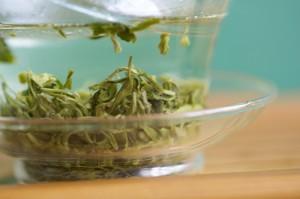On the 8th December 2002, the People’s Republic of China government officially approved the protection of the name ‘Dongting Biluochun’. Thereafter, only Biluochun from Dongting Mountain can be named “Dongting Biluochun”.
This was to protect the producers of the authentic Biluochun as well as prevent imitators from cashing in on the fame of Dongting Biluochun and besmirch the good name of this famous historical tea.
But we are getting ahead of ourselves.
A bit of Geography
View Larger Map
This is a map of Taihu or Lake Tai in Suzhou, Jiangsu Provice thanks to Google Maps.
What is known as Dongtingshan or Dongting Mountain is divided into Dongshan and Xishan which means east and west mountains respectively.
What is known as Dongshan is the peninsula on the map. Xishan County is found on the island though today it is also known as Jintingzhen or Jinting County.
Officially, only teas grown within this area can be known as “Dongting Biluochun”, an important distinction that we will see later.
As a side-note, this is distinct from Lake Dongting in Hunan near the origins of Junshan Yinzhen, a few hundred kilometers apart in fact.
Then a bit of History
It seems every bit of tea history inevitably has to include a reference to Lu Yu’s Cha Jing or “Classics of Tea”. If nothing else, it was the earliest comprehensive treatise on tea and probably one of the first place historians would look.
In Lu Yu’s Cha Jing- after that somewhat relevant tangent- it was recorded that Dongshan had been a major tea producing region at that time though Biluochun had yet to come into being.
In a Song Dynasty document- Wu Jun Tu Jing- dated 987 CE, it was recorded that Dongting tea had been a tribute tea- or teas sent to the royal family. However at that time, the tribute teas of the day were generally in the form of cakes like modern day Puer.
Centuries later, a Ming Dynasty publication dated 1506 indicates that the Dongting tea of that day had among other things the following 2 characteristics:
i) Picked before the harvest rain ~ 20th April
ii) Favored for delicate buds
Even if this was not the Biluochun of today, it began to take on the key characteristics.
The rest of tale has been covered – the “Frightening Fragrance” and the naming by Emperor Kangxi but the origins of Dongting Biluochun can be traced back to Dongshan- at least for 600 years.
Back to the Future
So that was geography and history.
Why does the “Dongting” in Dongting Biluochun matter?
Here are some key figures for the production of Biluochun in Wuzhong County- a 770 square kilometer county in Suzhou, Jiangsu. It includes Dongshan, Xishan but entails a far larger area.
Year Area of Tea Farms in Mu (1 Mu=0.67 sqkm) Total Production of Tea (mt) Total Production of Biluochun (mt)
1949 1756 66 11.8
1960 1766 122 20.8
1975 3345 200 13.6
1985 4198 164 22.6
1990 3246 168 19.9
1995 3100 106 33.4
2000 13200 120 36.5
2005 25200 226 118.7
Source: Dongting Biluochun by Zhang Wuwei, Yang Quan et al published by Shanghai Cultural Publications
While these figures are interesting and entail certain bits of history- Great Leap Forward, Cultural Revolution, economic reform, Suzhou growth etc- we will focus on what is pertinent.
Astute readers would realize that there is an explosion in the area of tea farms from 1995 to 2000 with the area virtually quadrupling.
In 2005 the production of Biluochun- that is Biluochun in general- for the County of Wuzhong nearly tripled.
The proliferation of non-traditional Biluochun in Wuzhong alone is astounding, to say nothing of other provinces like Yunnan, Sichuan among others.
Trademark Protection
At the state we mentioned that the protection of the name “Dongting Biluochun” was established in 2002.
It is not merely the Chinese fascination of the “original birthplace” that comes into play.

Hence, outside of Dongting, it is not as likely to find the traditional skills.
Secondly, the trademark protection goes beyond the production area.
In the official document GB 18957-2008 that governs the name, Dongting Biluochun must among other things:
i) Be picked before Harvest Rain (6.3.1)
ii) Tea trees grown among certain surrounding fruit trees including pipa, plum, chestnut etc with at least 25-35% coverage (6.2.1, 6.2.2)
iii) Tea tree grown among other trees with at least 80% coverage (6.1.4)
When you get a tea that can officially be recognized as Dongting Biluochun, you will expect it to be
i) Young and tender
ii) Possess fruity nuances in its taste and aroma
iii) Higher amino acid content- especially Theanine- due to shade from the surrounding trees- which in turn lends to a sweeter taste
This reminds me of the old Citibank advert- “It’s not just Visa. Citibank Visa”
When you are looking for the authentic taste that made it one of China’s best loved green tea, don’t just buy Biluochun, buy Dongting Biluochun.
See our Pre-Qing Ming Dongting Biluochun in stores today
See other articles related to different varieties of green tea here
